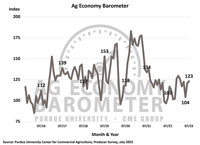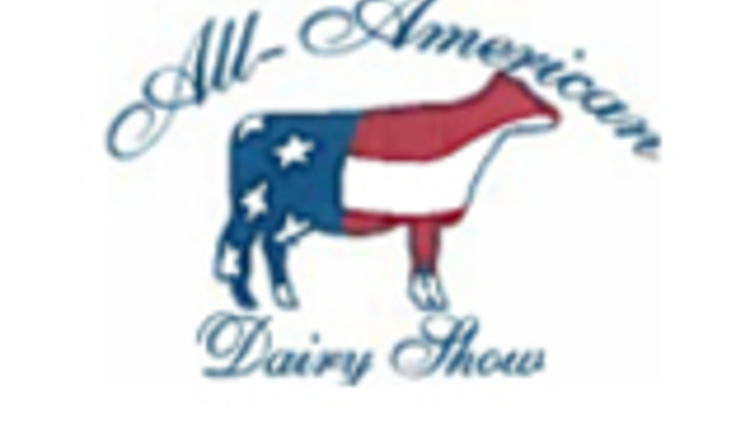
The information below has been supplied by dairy marketers and other industry organizations. It has not been edited, verified or endorsed by Hoard’s Dairyman.
Agricultural producer sentiment improved slightly in July as the Purdue University/CME Group Ag Economy Barometer index rose 2 points to a reading of 123. Farmers were also more optimistic about their perception of current conditions and future expectations on their farms. The Index of Current Conditions rose 5 points to a reading of 121, while the Index of Future Expectations was up one point to 124. The Ag Economy Barometer is calculated each month from 400 U.S. agricultural producers’ responses to a telephone survey.

“Producers were slightly more confident about the farming economy in July, despite recent crop price volatility and continued concerns about rising interest rates,” said James Mintert, the barometer’s principal investigator and director of Purdue University’s Center for Commercial Agriculture.
The improvement in farmers’ perspective on current conditions spilled over into a modest rise in July’s Farm Capital Investment Index, up 3 points to a reading of 45. However, the index has greatly improved, up 14 points, since bottoming out in November 2022. Comparing July’s responses to last fall’s low point, the percentage of producers saying now is a good time for large investments has improved from 10% who felt that way in November to 17% in July. Additionally, the percentage of farmers who feel it’s a bad time to invest was down from 79% who felt that way in November to 72% in July.
Surprisingly, the improvement in this month’s investment index occurred despite a rise in the percentage of producers who expect interest rates to rise over the next year. Nearly two-thirds (65%) of producers in July said they expect interest rates to increase, up from 57% in June. Among those who indicated that now is a bad time to make large investments, their top reason was concern about rising interest rates.
Given the volatility in commodity prices, especially crop prices, this spring and early summer, it’s notable that more producers expressed concern about rising interest rates than declining output prices. Producers’ top concern for their farming operations in the upcoming year is still higher input costs (37% of respondents), followed by rising interest rates (24% of respondents) and lower output prices (19% of respondents).
Confidence among farmers regarding the future direction of farmland values continues, even as nearly two-thirds of survey respondents expect interest rates to rise over the next year. The Long-Term Farmland Value Expectations Index remained unchanged in July at a reading of 151 while the Short-Term Farmland Value Expectations Index declined just one point to 125. This month, corn and soybean producers were once again asked about their farmland cash rental rate expectations for 2024. Similar to last month, nearly one-quarter (24%) of respondents expect rental rates to rise, compared to 2023, while just over 7 out of 10 (71%) of producers look for no change in rental rates.
Farmers’ rating of financial conditions on their farms was virtually unchanged in July, as the Farm Financial Conditions Index rose just one point to a reading of 87. When asked to look ahead one year, there was a 1 percentage point increase in farmers expecting farm financial conditions to improve over the previous month and a 1-point decline in the percentage of farmers expecting conditions to worsen. Farmers’ longer-term perspective on the U.S. agricultural economy did improve somewhat in July. The percentage of respondents expecting bad times in the upcoming five years fell 2 percentage points to 39% in July.
This month’s survey included several questions about crop farmers’ perspectives on cover crop usage. Nearly-half (45%) of corn/soybean farmers in this month’s survey indicated they currently use cover crops. This compares with responses from 2021 and 2022 barometer surveys, where a range between 41%-57% of respondents reported planting cover crops. Among cover crop users, the two most commonly cited reasons for using cover crops were to improve soil health and erosion control (65% of July respondents), which is in line with prior barometer surveys in 2021 and 2022 when 58%-70% of respondents said they chose soil health and erosion control as their motivation for using cover crops.
Those who indicated using cover crops were also asked to describe their experience. Four out of five (80%) farmers said it improved soil health and yields, while 15% of respondents said cover crops improved soil health but did not improve yields. In prior barometer surveys, a range of 74%-84% of respondents said cover crops improved soil health and yields, while 9%-18% of respondents said it improved soil health but did not improve yields.
Read the full Ag Economy Barometer report at https://purdue.ag/agbarometer. The site also offers additional resources – such as past reports, charts and survey methodology – and a form to sign up for monthly barometer email updates and webinars.
Each month, the Purdue Center for Commercial Agriculture provides a short video analysis of the barometer results, available at https://purdue.ag/barometervideo. For more information, check out the Purdue Commercial AgCast podcast available at https://purdue.ag/agcast, which includes a detailed breakdown of each month’s barometer and a discussion of recent agricultural news that affects farmers.
The Ag Economy Barometer, Index of Current Conditions and Index of Future Expectations are available on the Bloomberg Terminal under the following ticker symbols: AGECBARO, AGECCURC and AGECFTEX.



